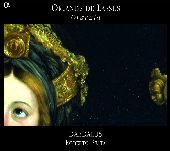Lassus - Oracula
Label: ALPHA Catalog: ALPHA095 Format: CD 1 CD - Label: Alpha - ALPHA095 - Lectiones Sacrae Novem, Ex Libris Hoib Excerptae - Lassus, Orlandus - Ensemble: DaedalusRoland de Lassus (1532-1594) Oracula: Prophéties de la Sibylle, Lectiones Sacrae Novem, ex libris Hiob exerptae (Lectio prima; Lectio secundo; Lectio tertia; Lectio quarta; Lectio quinta; Lectio sexta; Lectio septima; Lectio octava; Lectio nona; Prophéties de la Sibylle - Prologue; I - Sibylla Persica; II - Sibylla Lybica; III - Sibylla delphica; IV - Sibylla Cimmeria; V - Sibylla Samia; VI - Sybilla Cumana; VII - Sibylla Hellespontica; VIII - Sibylla Phrygia; IX - Sibylla Europaea; X - Sibylla Tiburtina; XI - Sibylla Erythraea; XII - Sibylla Agrippa In Christian iconography, the twelve Sibyls and the twelve Prophets are traditionally represented side by side. So it is no mere coincidence that the 'Prophetiae Sibyllarum' (Sibylline Prophecies) and the 'Novem Lectiones Sacrae ex libris Hiob' (Nine Sacred Readings from the Prophet Job) by Roland de Lassus (1530/32-1594) are found together in the same manuscript (Austrian National Library, Vienna) and also presented together here. The Book of Job provides an interesting parallel with the Christianized texts of the Sibyls. And both Job and the Sibyls prefigure the coming of Christ. The Sybil was a priestess, a woman who uttered predictions in ecstatic frenzy. Existing since time immemorial, she made prophecies throughout the history of the Greeks, Jews and Christians. In the late Middle Ages, the Church adopted the symbol and began to associate the Sibyls with the Prophets as a means of justifying the diffusion of Christianity: the Prophets had announced the good news to believers, and the Sibyls to heathens. The 'Prophetiae Sibyllarum' by Roland de Lassus are among the composer's most engimatic works, and they are well known. But this is the first ever recording of his second version of the 'Lectiones Sacrae ex libris Hiob' (c1582) - one of the most extraordinary motet cycles of the musician's maturity. The cycle is esoteric and sophisticated, subtle and refinded. The meditative nature of the texts, the polyphony - or rather the responsorial style that was practised in the liturgy - and the dedication to a patron, make this cycle a perfect example of 'musica reservata'. |












